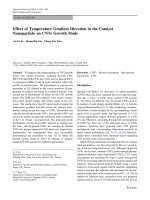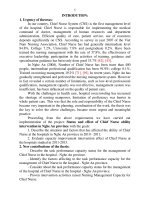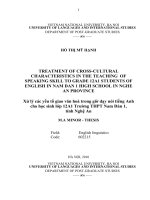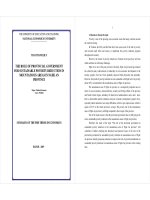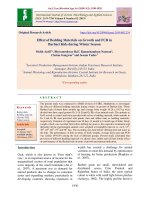Effect of fertilizer and mulching materials on growth and yield of sesame variety VD11 in Nghe An province
Bạn đang xem bản rút gọn của tài liệu. Xem và tải ngay bản đầy đủ của tài liệu tại đây (134.49 KB, 5 trang )
Journal of Vietnam Agricultural Science and Technology - No.1(3)/2018
transgenic crop plants. Proceedings of First National
Conference on Crop Sciences, p255-262. (in Vietnamese).
Nguyen KL, Lo TMT, Le THT, Nguyen THY, Chu HM,
2016. Evaluation of soybean mosaic virus resistance
in transgenic lines expressing RNAi constructs.
Science and Technology, p101-106 (in Vietnamese).
Nguyen VM, Le DT, Pham TBC, Le TAH, Le HH,
2016. Result of research and development of
DT2008DB soybean variety. Proceedings of Second
National Conference on Crop Sciences, p488-493
(in Vietnamese)
Palmer RG, Pfei er TW, Buss GR, Kilen TC, 2004.
Qualitative genetics Soybeans: improvement,
production, and uses 3rd ed. Madison (WI): ASA,
CSSA, and SSSA. p. 137-214.
Pham TBC, 2015. Soybean breeding for some provinces
of Northern Vietnam. Doctor of Agronomy, Vietnam
Academy of Agricultural Sciences, Hanoi, Vietnam.
Pham TD, Tran VH, Pham NT, Tran NN, Zhang Z,
2016. Co-expression of 3 genes crtB, At-VTE3
and VTE4 in soybean. Agriculture and Rural
Development, p3-10 (in Vietnamese).
Reese PFJ, Boerma HR, 1989. Additional genes for
green seed coat in soybean. J Hered, 80 (1): 86-88.
Tran TCH, Nguyen THB, Tran TH, Ho TQN, Ha
ML, Nguyen QV, Tran NN, Vo TKT, Doan TM,
Pham TH, Nguyen DC, 2013. Studies on development
of transgenic soybean varieties resistant to the lesser
cornstalk borer and the pod borer. Proceedings of
First National Conference on Crop Sciences, p441 - 449
(in Vietnamese).
Tuteja JH, Zabala G, Varala K, Hudson M, Vodkin LO,
2009. Endogenous, tissue-speci c short interfering
RNAs silence the chalcone synthase gene family in
Glycine max seed coats. Plant Cell, 21: 3063-3077.
USDA, 2016. Visual Reference Library - Soybean.
https://ww w.gipsa.usda.gov/vr i/soybean_of36.0.aspx, accessed on 3/10/2018.
USDA, 2018. World Agricultural Production. https://
apps.fas.usda.gov/psdonline/circulars/production.
pdf, accessed on 1/11/2018.
Woodworth CM, 1921. Inheritance of cotyledon, seedcoat, hilum, and pubescence colors in soybeans.
Genetics, 6 (6): 487-553.
Yang K, Jeong N, Moon JK, Lee YH, Lee SH, Kim
HM, Hwang HC, Back K, Palmer GR, Jeong CS,
2010. Genetic analysis of genes controlling natural
variation of seed coat and ower colors in soybean.
J Hered, 101 (6): 757-768.
Zeng P, Vadnais DA, Zhang Z, Polacco JC, 2004.
Re ned glufosinate selection in Agrobacteriummediated transformation of soybean [Glycine max
(L.) Merrill]. Plant Cell Reports, 22 (7): 478-482.
Date received: 3/11/2018
Date reviewed: 9/11/2018
Reviewer: Dr. Duong Xuan Tu
Date approved for publication: 21/12/2018
EFFECT OF FERTILIZER AND MULCHING MATERIALS ON GROWTH
AND YIELD OF SESAME VARIETY VD11 IN NGHE AN PROVINCE
Le Kha Tuong*1, Nguyen Trong Dung1
Abstract
Sesame is one of three important crops in the crop rotation system in Nghe An, including spring groundnut, summer
sesame and winter crops. However, in recent years, climate change in the central provinces has been seriously a ecting
this cropping system. Among a ecting factors, high temperature and prolonged drought are the main causes of decline
on productivity and economic e ect in sesame production in Nghe An province. So applying of appropriate mulching
materials and variety is an important technique to reduce evapotranspiration and high temperature in soil to maintain
growth and stability of sesame plants in climate change conditions. e results showed that application of appropriate
fertilizer and mulching materials simultaneously produces a lm that reduces temperature, increases the soil moisture
in hot dry conditions. ereby, it increased the plant height, number of nodes per stem and reduced the bacterial wilt,
and increased dump resistance and limited yield losses. erefore, in the condition of climate change in Nghe An,
application of fertilizer 40 kg N + 120 kg P2O5 + 80 kg K2O + 200 kg lime combined with black nylon muching of 110
kg/ha is the optimal solution to increase sesame productivity by more than 20% compared to the control.
Keywords: Fertilizer, Mulching materials, Nghe An, temperature, sesame
1
*
Plant Resources Center
Corresponding author: Le Kha Tuong. Email:
37
Vietnam Academy of Agricultural Sciences (VAAS)
INTRODUCTION
Nghe An is a province with a sesame production
scale of over 10,000 ha/year, accounting for 30% of
the total area and nearly 40% of the national sesame
production (Le Kha Tuong, 2009). In this province,
sesame is grown mainly on sandy soils and lowland
in the delta. Sesame is one of three important crops
of crops system: spring groundnut, summer sesame
and winter vegetables (Nghe An Crop Production
and Plant Protection Sub Department, 2016). Hence,
sesame production is an important income source of
Nghe An farmers. However, in recent years, global
climate change in general and Vietnam in particular
have severely a ected the sesame production in
Nghe An with thousands of hectares drought-free
harvested, many areas fallowed in summer or crop
change but not e ective (Le Kha Tuong, Nguyen
Trong Dung, 2013). So, research on the application
of drought tolerant varieties and the use of suitable
mulching materials is an important measure that
contributes to limiting evapotranspiration and high
temperatures in cultivated soils, ensuring of sesame
crops can be growth and develop in the condition of
climate change in Nghe An.
MATERIALS AND METHODS
Materials
New sesame variety - VD11 has been recognized by
the Ministry of Agriculture and Rural Development
for trial production in the North Central provinces
according to Decision No. 83/QD-TT-CCN, dated
7 March 2013 (Department of Crop Production,
MARD, 2013). Use of fresh peanut plants, black and
white nylons for mulching, application of urea, super
phosphate, KCL fertilizer, Song Gianh microbial
organic fertilizer, Growmore fertilizer, lime powder.
Methods
e experiment consisted of two levels of fertilizer
and four types of mulching materials (Table 1), which
were formulated into 8 treatments: (1) PB1CP1;
(2) PB1CP2; (3) PB1CP3; (4) PB1CP4; (5) PB2CP1;
(6) PB2CP2; (7) PB2CP3; (8) PB2CP4. e experiments
were arranged in a randomized complete block design
(RCBD) with 3 replications, plot area of 50 m2.
Table 1. Fertilizer amount and mulching materials in experiment
Experimental Treatment
Mass
Fertilizer PB1
40 kg N + 120 kg P2O5 + 80 kg K2O + 200kg lime powder
Fertilizer PB2
40 kg N + 120 kg P2O5 + 80 kg K2O + 200 kg lime powder + 3 kg Growmore
Remove mulch CP1
No mulching (control)
Remove mulch CP2
Fresh groundnut plants 15 tons/ha
Remove mulch CP3
Black nylon 110kg/ha
Remove mulch CP4
white nylon 100kg/ha
Determination of soil moisture and temperature at
20 cm depth by the Shinwa machine 72716 produced
by Japan. In the range of soil moisture contents from
very dry to saturated, the soil temperature ranges
from -9 to 500oC. Evaluation of the bio-agronomic
characteristics of the sesame plant by descriptors of
the Plant Resources Center (2012). Determination
of the possibility of bacterial wilt infection under
the eld condition was followed by the guidance of
the Plant Protection Department in 1995 including
9 levels as follows: Disease rate (%) = [Number of
diseased plants: total number of surveyed plants ]
˟ 100%; Level 1: Resistance: no dead plant; Level 3:
mild infections: from 1 to 10% died plants; Level 5:
Moderate infection: from 11 to 25% died plants; Level
7: Infections: from 26 to 50% death plants; Level 9:
Severe infections: > 50% died plants. Evaluation of
38
anti-dumping was performed by ICRISAT’s point as
showed in Table 2.
Table 2.
e point scale for dump evaluation on the eld
Dump
Corner
0 - 9o 10 - 19o 20 - 29 o 30 - 39o > 60o
Dump
area (%)
0 - 19
1
1
1
1
1
20 - 39
1
1
3
3
5
40 - 59
1
3
3
5
7
60 - 79
1
3
5
7
9
> 80
1
3
5
7
9
Data processing: e data was processed by in Excel
and IRRISTAT version 5.0.
Journal of Vietnam Agricultural Science and Technology - No.1(3)/2018
Time and place of the study
ground, contributing to maintain water supply
capacity for sesame. Without mulching, soil moisture
has been signi cantly reduced in sandy soils and light
soils, whereas in muching conditions, soil moisture
was maintained within the range of 74 - 770 on soil sand
and 75 - 790 light land. e results also showed that
the application of di erent fertilizer levels negatively
a ects soil temperature and moisture (Table 3).
e experiment was conducted in sandy soil Dien
Hung commune - Dien Chau district - Nghe An
province from 2016 to 2017. Sowing time: 15/5/2016
and 20/5/2017.
RESULTS AND DISCUSSION
E ect of fertilizers and mulching materials on soil
temperature and humidity
E ect of fertilizer and mulching material on the
growth of the sesame variety VD11
Previous researches showed that the use of mulching
materials would create a membrane between the
upper and lower (F. Fazeli et al., 2007).
In general, the interaction of fertilizer dose and
mulching material did not a ect plants from sowing
to germinating, but it a ected plant height, number
of nodes/stem and number of owers/axillary. Under
no mulching condition on two levels of fertilizer,
Growth period was shortest with 85 days. While using
of mulching materials duration the plant growth
duration increased from 88 - 90 days on both fertilizer
doses. So using muching materials, the temperature
and humidity of soil were maintained at normal levels,
suitable for growing of sesame plants. is is a basic
condition, contributing to maintain the growth rate
of plant height and number of nodes/stems of sesame
plants.
erefore, under uncovered conditions,
the plant height and number of nodes/stems were
signi cantly reduced, corresponding to 61.2 cm and
19.2 nodes/stem at PB1 level; 63.2 cm and 18.6 nodes
per stem for PB2. While using mulching material the
plant height increased and varied from 65.2 to 74.8
cm on PB1 and 66.3 to 74.3 cm on PB2. In particular,
the di erences in the fertilizer doses and mulching
materials signi cantly in uenced the number of
owers/axillary shoots, in which covered by black
nylon increased the number of owers/axillary at the
highest level, corresponding to 4.0 owers in PB1CP3
and 4.2 owers in PB2CP3 (Table 4).
Table 3. E ect of fertilizer and mulch material
on soil moisture and temperature in sesame production
in Nghe An province, 2016 - 2017
Formula
PB1CP1
PB1CP2
PB1CP3
PB1CP4
PB2CP1
PB2CP2
PB2CP3
PB2CP4
Soil temperature
(0 C)
Sandy
Light
35
33
29
28
27
26
28
27
34
33
28
26
26
26
27
27
Soil moisture
(%)
Sandy
Light
65
69
75
76
77
78
76
77
66
69
74
75
77
79
75
77
e results showed that under summer conditions,
this lm reduced the temperature and increased soil
moisture in both sandy soil and light soil in Nghe An
province. In which, a strongest decrease was seen in
the black plastic cover, followed by white nylon and
fresh groundnut plants. Especially the membranes
separated the evaporation of water vapor from the
Table 4. E ects of fertilizer and mulching material on the growth
of the sesame variety VD11 in sandy soil in Nghe An province, 2016 - 2017
Formula
PB1CP1
PB1CP2
PB1CP3
PB1CP4
PB2CP1
PB2CP2
PB2CP3
PB2CP4
Growth period
Sowing
owering
(day)
(day)
4
35
4
35
4
35
4
35
4
35
4
35
4
35
4
35
Duration
(day)
Plant height
(cm)
Number
of Nodes/
stem
Number
of Flowers/
axillary
85
87
90
90
85
88
90
90
61.2
65.2
74.8
73.5
63.2
66.3
72.4
74.3
19.2
20.0
22.4
22.3
18.6
19.5
23.4
22.7
2.5
3.2
4.0
3.8
2.7
3.3
4.2
3.9
39
Vietnam Academy of Agricultural Sciences (VAAS)
e e ect of fertilizer and mulching material on
bacterial wilt and dump resistance
Bacterial wilt (Raltonia solanacearum Smith) is a
major disease of sesame plants. e results of study
on the e ect of interaction between fertilizer and
mulching material on the harmful of this disease
on sesame in Nghe An province showed that in the
uncovered condition, it was light level (Level 3) on
both fertilizer substrates, while using of di erent
mulching materials it increased the highest resistance
(Level 1) to this disease on both fertilizers. Surveys of
dump resistance in di erent fertilizer and mulching
materials showed that the mulching materials
increased anti-dump comparing to no muching.
In which mulching by black nylon was the highest
(Point 1) in anti-dump, uncovered made of dump area
from 20 to 39% and inclined > 600 (Point 5). is is
explained by the fact that under covering conditions,
soil moisture and temperature were suitable for root
growth to increase anti-dump of sesame comparing
to no-mulching (Table 5).
Table 5. E ect of fertilizer and mulching material on bacterial wilt infestation and anti-dump
of sesame variety VD11 in sandy soil -Nghe An province in the period 2016 - 2017
Fomula
PB1CP1
PB1CP2
PB1CP3
PB1CP4
Bacterial wilt
3
1
1
1
Anti-dump
5
3
1
3
e e ect of fertilizer and mulching material on
yield components
e results showed that the dosage of fertilizer and
mulching materials has a signi cant in uence on
the temperature, moisture of soil, to growth and
development of sesame. is is the scienti c basis
to change the yield components in sesame in the
condition of climate change in Nghe An. Speci c
research results showed that by using di erent
fertilizers and mulching materials increased the
number of pods from 25.4 to 26.2 pods/plant in
uncovered condition and increased from 28.2 - 32.6
pods/plant under mulching conditions. e results
also noted that the use of di erent fertilizers and
mulching materials did not signi cantly increase the
number of seeds/pod and the seed thousands weight.
However, di erent fertilizer and mulching materials
signi cantly increased yield of sesame variety VD11.
Based on fertilizer PB1 (40 kg N + 120 kg P2O5 +
80 kg K2O + 200kg lime powder) , in the uncovered
condition, the yield was 1,002 tons/ha, when applying
muching it increased from 1.107 to 1.420 tons/ha;
based on PB2 fertilizers, in the uncovered condition
the yield was 1.059 tons/ha, when applying di erent
mulching materials, the productivity increased from
1.152 to 1.331 tons/ha. Comparison results on 2
fertilizers levels and 4 mulching materials showed
that application of PB1 fertilizer level and black
nylon mulch reached the highest yield (1.42 tons/ha),
followed by white nylon and fresh groundnut
(Table 6).
40
Fomula
PB2CP1
PB2CP2
PB2CP3
PB2CP4
Bacterial wilt
3
1
1
1
Anti-dump
5
3
1
3
Table 6. E ects of fertilizers and mulching materials
on yield components and real yield of
sesame variety VD11 in Nghe An province, 2017
Formula
Number
of Pods/
plant
Number
of Seeds/
pod
1000
seeds
weight
(gr)
Yield
(tons/
ha)
PB1CP1
25.4
21.7
2.1
1.002
PB1CP2
28.6
21.8
2.1
1.107
PB1CP3
31.4
21.4
2.2
1.420
PB1CP4
31.2
22.8
2.1
1.416
PB2CP1
26.2
20.6
2.2
1.059
PB2CP2
28.2
21.0
2.1
1.152
PB2CP3
32.6
21.1
2.2
1.331
PB2CP4
30.2
21.1
2.2
1.247
CV (%)
4.7
LSD0.05
0.12
CONCLUSIONS AND RECOMMENDATIONS
Conclusions
- Use of black nylon in summer sesame production
in Nghe An is the optimal solution to reduce the
temperature, increase the soil moisture in dry
conditions and high temperature due to climate
change. e di erent mulching materials have ability
to maintain soil moisture from 74 - 77 % on sandy
soils, 75 - 79 % on light soil.
Journal of Vietnam Agricultural Science and Technology - No.1(3)/2018
- e application of mulching materials in sesame
production in Nghe An increased plant height
from 65.2 - 74.8 cm on fertilizer level PB1 and 66.3
- 74.3 cm on fertilizer level PB2. e di erences of
fertilizer doses and mulching materials signi cantly
in uenced the number of owers/leaf axillary, in
which black nylon cover increased the number of
owers/axillary at the highest level, corresponding
to 4.0 owers in the PB1CP3 formula and 4.2 owers
in the PB2CP3 formula.
- By using of di erent cover materials, the bacterial
wilt resistance was at the highest level (Grade1). By
di erent covering materials, it also increased antidumping e ect, in which black nylon muching was
the highest (Point 1).
- e application of fertilizer level of 40 kg N + 120
kg P2O5 + 80 kg K2O + 200 kg of lime combined with
black nylon cover of 110 kg/ha or white nylon cover
of 100 kg/ha gave the highest yield of 1.4 tons/ha, up
40% compared to uncovered.
Recommendations
e application of fertilizer level of 40 kg N + 120 kg
P2O5 + 80 kg K2O + 200 kg lime powder combined
with black nylon cover of 110 kg/ha or white nylon
cover of 100 kg/ha was recommended for the summer
sesame production in Nghe An.
REFERENCES
Department of Crop Production, MARD, 2013.
Decision on recognition of new agricultural plant
varieties 83/QD-TT-CCN, dated on 7 March 2013.
F. Fazeli, M. Ghorbanli and V. Niknam, 2007. E ect
of drought on biomass, protein content, lipid
peroxidation and antioxidant enzymes in two sesame
cultivars. Biology Plantarum, 51 (1): 98-103.
Nghe An Crop Production and Plant Protection
Sub-department, 2016. Report on cropping and
plant protection in 2016, work plan 2017. Nghe An
Department of Agriculture and Rural Development,
No. 267/BC-TT on 20/12/2016, p. 5-11
Plant Resources Center, 2012. Form for evaluation
of sesame gene sources. Plant Genetic Resources
Assessment Form, Hanoi, p. 45-46.
Le Kha Tuong, 2009. Proposals for research on sesame
variety selection for drought resistant in Nghe An
province, ADB project, Hanoi.
Le Kha Tuong, Nguyen Trong Dung, 2013. Report on
research results and trial of sesame variety VD11.
Plant Resources Center, Hanoi.
Date received: 15/9/2018
Date reviewed: 23/9/2018
Reviewer: Assoc. Prof. Dr. Ninh i Phip
Date approved for publication: 25/10/2018
EFFECT OF THERMAL PROCESSING ON QUALITY
AND ANTIOXIDANT ACTIVITY OF MIXED GAC (Momordica cochinchinensis)
- PAPAYA (Carica papaya) JUICE
Nguyen Minh
uy*1, Ngo Van Tai1, Tran Quang Linh1, Nguyen
i Truc Ly1
Abstract
e experiment was conducted on a gac-papaya juice to determine the e ects of cooking conditions (open boiler
system and closed system) on product quality and antioxidant activity. e samples were subjected to cooking
for di erent lengths of time for each of the processing conditions. e main e ect of cooking condition (time,
temperature, type of cooking) was determined by using ANOVA. e physicochemical properties and antioxidant
activity of the product were measured. e physicochemical properties (Brix, pH and viscosity) of gac-papaya
juice changed signi cantly during heating time. e lycopene content signi cantly increased (p < 0.05) when the
period of boiling increased (at di erent cooking conditions) between 0 to 5 minutes. However, both the b-carotene
and the Vitamin C content decreased signi cantly (p < 0.05) as boiling period increased between 0 to 5 minutes.
Processing of juice in open boiler system led to a signi cant decrease in ascorbic acid and beta-carotene whilst
vacuum cooking preserved these compounds. e degradation of these compounds followed a rst-order model.
e antioxidant activity (AA) of these products (i.e. boiling in closed and open system) was also determined. In both
boiling conditions, signi cant increasing antioxidant activity was found.
Keywords: Antioxidant activity, boiled, gac, papaya, physicochemical properties
1
*
Department of Food Technology, College of Agriculture and Applied Biology, Can
Corresponding author: Nguyen Minh uy. Email:
o University
41

